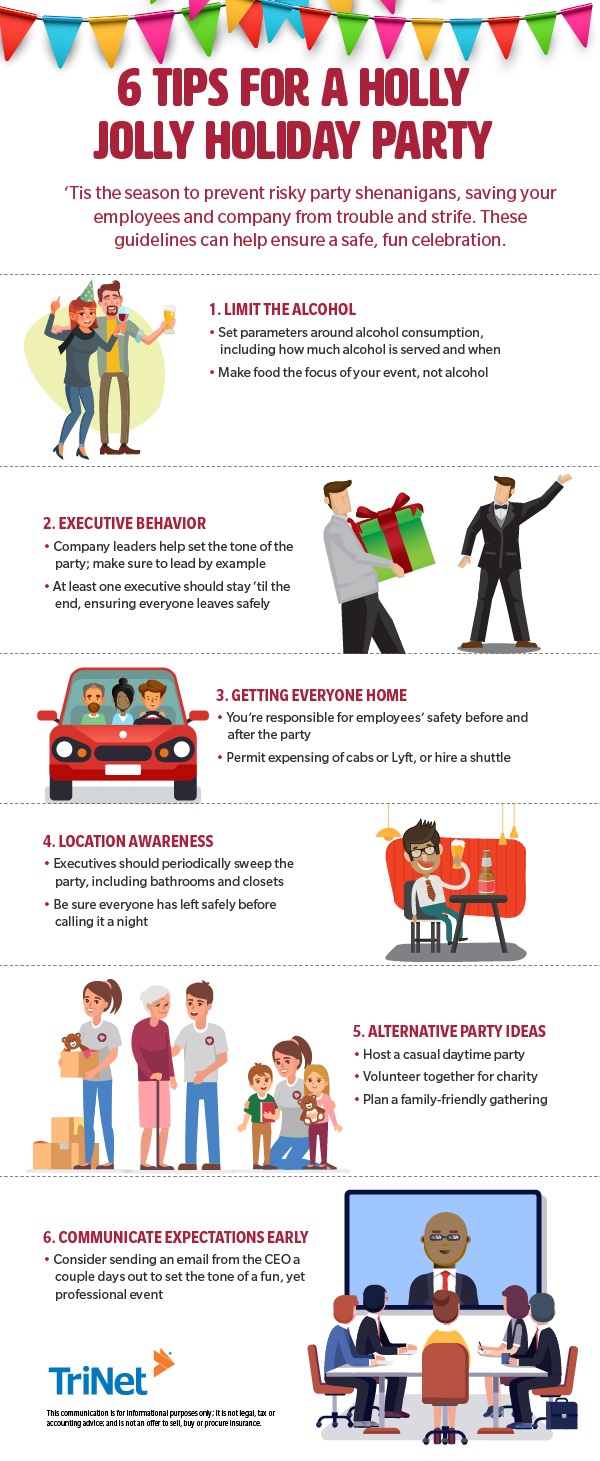Don’t Get Sued Because of Your Holiday Party: 6 Tips for Minimizing Risk and Keeping Employees Safe at Your Seasonal Soiree

The holidays are a great time for companies to celebrate their achievements and show appreciation for their employees. One popular way to do this is through an annual holiday party. While these parties are a fantastic way for colleagues to come together, unwind and enjoy each other’s company, they can also be fraught with risk for employers who aren’t careful. Every year we work with clients who, for one reason or another, find themselves in hot water after a holiday party. More often than not, these situations could have been prevented with some additional foresight.
Here are some of our suggestions, based on years of experiences with our small business clients, for hosting a holiday party that is fun and safe for everyone.
1) Limit the alcohol
This one may sound obvious but many people don’t know what limiting alcohol looks like at a company party, especially when employees have come to expect they’ll be able to drink. While having no alcohol at your party can clearly do a lot to minimize risk, you don’t have to go that far if holiday “spirits” are something you want to offer. Here is what I recommend:
- Don’t allow executives to drink. If this is just too restrictive, limit them to just one alcoholic beverage. Your executives should be the eyes and ears of your company at your holiday party. This isn’t to say that they can’t have fun but they should also be paying attention to make sure everyone else is safe and on their best behavior.
- Set parameters for when alcohol is served and how much. Work with your vendor or events team to only serve alcohol during dinner, have controlled/light pours, have a designated cut-off time and/or offer a two-drink maximum per person.
- Make sure there is plenty of food being served. While an appetizer-only party may be easier on the budget, it’s a better practice to make food the focus of your party and not alcohol.
2) Charge your leaders with being examples
The leaders of your company should be the thermometer of the party, not the temperature gauge. In other words, they set—not follow—the tone. We already said they shouldn’t be drinking (or, at least, shouldn’t be drinking much) but it is also important that they understand they are also responsible for setting the example of professional behavior at your company party.
Additionally, your company’s founder, CEO or at least one of your executives should remain until the end of the party to make sure things end on a positive note.
3) Take steps beforehand to ensure everyone gets home safely
Even if you aren’t offering alcohol, you can’t always control how much people end up drinking before, after (or even during) your holiday party. Whether or not you provided them with booze, you are still responsible for their safety.
While I have seen companies encourage carpooling or even reward employees who stay sober so they can drive their colleagues home, I don’t recommend this option and here’s why: when one employee gives another a ride home, you run the risk of something happening between them. This “something” may be completely innocent but if one person’s actions are misconstrued and/or taken negatively by another, it will fall on you to investigate it and you could potentially be liable for the outcome.
One alternative I’ve seen companies use to help their employees get home safe is allowing employees to expense a cab or ride share (such as Lyft) home from the party--and even back to the party location the next day to pick up their car, if required. Some companies go even further and hire drivers or shuttles who are charged with taking employees home.
4) Be cognizant of location
When choosing a venue for your party, think about how location may play into your overall risk. Are there bars, clubs and other places close by that groups of people may drink at before or after the party? The hours after your event ends may still be considered a company-sanctioned event, meaning you could be held responsible for anything that happens to one of your employees after the party ends.
It can help if the leadership team is circulating and mingling throughout the party. Do a sweep of the entire event area (including closets and bathrooms) periodically during and especially after the event. I have seen more than one company be held responsible for an employee being found black-out drunk in a closet or an office after a holiday party. Make sure everyone has truly gone home safely before calling it a night.
5 Consider alternatives to the traditional evening party
Some companies have great success celebrating the holidays with a casual day party, by volunteering together for a charity or holding a family-friendly affair at a bowling alley or somewhere more low-key. These types of activities allow employees to get into the holiday spirit without the higher-risk party atmosphere.
6) Communicate expectations ahead of time
No business leader wants to come off as the holiday Scrooge but it’s very important, if you want to have a controlled event, to communicate ahead of time to your employees what is expected of them. I recommend a brief email from your CEO, sent a few days before the party, thanking your employees for a great year, letting them know that you look forward to a fun party and reminding them that it is still a work setting in which they are expected to exhibit professionalism and decorum. Include your company’s code of conduct and reiterate your policies for drinking and transportation home.

This communication is for informational purposes only; it is not legal, tax or accounting advice; and is not an offer to sell, buy or procure insurance.






